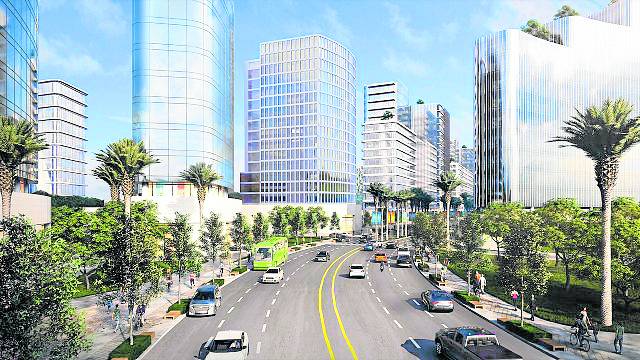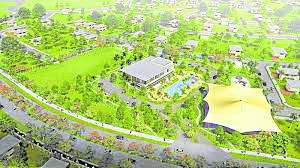The future of PH real estate
It has been a tumultuous 20 months for the Philippine real estate industry.
As the COVID-19 pandemic and the ensuing lockdowns continue to take a heavy toll on economies, creating a landscape that remains challenging and uncertain even until today, real estate players had to quickly rethink, retool and recalibrate their strategies to adapt with the sweeping, unprecedented changes that have upended the industry since last year.
It has been a tough balancing act: stringent restrictions hampered all movements, projects, and sales activities, prompting developers to explore for more effective ways to reach out to their customers to sustain sales, while managing employees most of whom were forced to work from home due to the pandemic. At the same time, health and safety considerations have become priorities, which meant that developers needed to set in place the government-mandated protocols within their offices and project sites while ensuring that their future projects will be suited to what is now called as the new normal. And almost two years into this pandemic, property developers have managed to adapt.
It’s still too early to tell by this time if the real estate industry is truly on its way to bouncing back better from this crisis, as the future landscape remains uncertain and fluid owing to possible new developments concerning the pandemic.
But there’s reason to believe in the guarded optimism underpinning the forecasts of some of the country’s top consultancy firms.
While the industry, as with the rest of the country, has not yet recovered from the pandemic slump, some subsectors have begun showing encouraging signs of gradual rebound. There are also silver linings—bright spots that helped keep the industry afloat and resilient since the pandemic struck early last year.
Inquirer Property polled property consultancy firms to get their insights and fearless forecasts about the Philippine real estate industry in 2022 and beyond the pandemic.
RECOVERY BECKONS IN 2022
Sheila Lobien
Lobien Realty Group (LRG)
It will be a recovery year for the Philippine real estate industry next year.
Real estate is sensitive to economic growth and the Philippines is projected by Goldman Sachs to register next year the fastest gross domestic product (GDP) growth among the Asean 5 at 7.3 percent.
In the office space market, the financial resiliency of landlords has been observed the past two years as seen in the absence of an asset sale significant enough to be noticed by the industry.
The decrease in rent has been within range as well, despite the double-digit vacancy rates in the major central business districts in the National Capital Region. We always tell landlords that weak demand should be considered as a temporary issue.
On the ground, we are already seeing significant movements from the tenant side, but most are looking at closing their deals during the first half of 2022. Still, at Lobien Realty Group, we see that it will be a tenant-driven market for the next two to three years.
On the tenant side, we advise them to start hunting for their office space as early as now in preparation for this expected recovery.
Commercial spaces are expected to also pick up, while last to recover will be the hotel industry given the continuing restrictions and low traveler confidence.
Meanwhile, the housing and warehousing markets were the bright spots during the pandemic.
Despite the economic challenges, demand was also robust in the housing market, where we saw prices holding their ground and even increasing in the high single digits. The warehousing industry, expectedly, was propped up by the six-fold increase in online sales for the past five years.

Growth drivers
The main driver of the recovery will be our ability to control the COVID-19 situation, which will rely heavily on our vaccination speed.
We currently no longer have vaccine supply issues, so we just need to vaccinate as quickly as possible. Of course, the government’s monetary and fiscal policies should continue—which shall include lower interest rates and infrastructure spending.
Hopefully, the upward trend in remittances of overseas Filipino workers (OFWs), higher employment rate, lower inflation, and the expected higher government and consumer spending will allow the economy to recover.
For the headwinds, we are seeing a resurgence of COVID-19 in other countries and we hope that we do not experience the same here in the Philippines. Vaccination and boosters should be aggressively pushed.
Pandemic-proof investments
We have seen that demand for higher-end condos, single detached homes and residences situated in townships grew during the pandemic.
The common denominator is that homebuyers and investors want to pandemic-proof their residential investments: bigger is better for the family’s manifold purposes such of working from home and online schooling, while a township setup ensured easy transport to their offices, groceries, drugstores as well as lower exposure to COVID-19 during the commute.
The value of farm lots and beachside homes—in terms of health, mental and social factors—has been magnified by the pandemic.
If ever there will be a return to prepandemic preferences, it will take a long time—probably at least a decade. The shock value of the pandemic will remain with all of us for a long time and will greatly impact our real estate decisions in the next several years.
STABLE ENVIRONMENT, GRADUAL REBOUND
Joey Roi Bondoc
Colliers Philippines
The gradual re-opening of the economy bodes well for Philippine property. This could result in greater office and pre-selling condominium take-up over the next 12 months. Malls are starting to welcome more consumers and this should translate to improved retail space absorption and eventual recovery in rents.
Vaccination drive, economic rebound
In 2022, we see a more stable office leasing environment. We project a greater demand for healthy and sustainable buildings. Transactions outside of Metro Manila will likely continue.
Colliers believes that office leasing recovery will be anchored by ramped up inoculation and potential rebound in outsourcing demand following the recovery of major economies such as the United States.
Colliers expects the successful roll out of the vaccination program, economic rebound and re-absorption of office space to also bolster demand for both pre-selling and secondary residential markets. We believe that competitive mortgage rates and stable remittances from overseas Filipino workers (OFW) are likely to support residential sales growth.
A gradual rebound of rents and prices in the second half of 2022 is seen, with the easing of restrictions in Metro Manila potentially buoying demand in the secondary residential market.
Rents of retail spaces are also seen to recover slowly starting 2022 on the back of an improved vaccination program and a government-projected economic recovery, which should spur spending.
The easing of lockdowns has allowed the reopening of entertainment facilities such as arcades and cinemas. As consumer traffic remains below prepandemic levels, Colliers recommends that mall operators use vacant space for pop-up stores, for vaccination drives and for alternative dining options.
Colliers meanwhile sees a slow recovery for the leisure sector especially with domestic and international travel restrictions still in place and with new virus variants dampening consumer confidence.
In contrast, the industrial sector is seen to thrive beyond 2022 as we see recovery in both local and global demand—sustaining the growth of e-commerce, domestic manufacturing and the export sectors.

Headwinds and tailwinds
Factors that may affect property recovery include the emergence of new COVID-19 variants, which could urge the government to re-impose stricter lockdowns; travel restrictions which may affect the revival of the leisure segment; weakened demand from Philippine offshore gaming operators (POGOs); and delayed completion of major infrastructure projects.
Potentially helping boost the sector is a higher than expected GDP growth. Credit rating firms, multilateral and government agencies are now projecting full-year GDP growth to reach between 4 and 5 percent, before a faster recovery in 2022.
Increase in OFW remittances should also support demand for affordable to mid-income residential units as well as retail spending starting in the fourth quarter of 2021.
Other tailwinds include vaccination rate improvement, rebound in consumer and business outlook, and competitive mortgage rates.
Moving forward
Based on our Q3 2021 Property Market Survey, 34 percent of the respondents said that at least half of their workforce are returning to their traditional offices starting 2022. This signifies that occupiers are considering a hybrid working model. Meanwhile, 31 percent answered that all their employees will work on-site in 2022.
In our view, any rebound in office leasing will be supported by the successful inoculation which should allow more employees to report back to their offices.
An earlier survey showed that 46 percent are likely to acquire a house and lot in provincial locations, 35 percent will buy or invest in a condominium in the fringes of CBDs, and 19 percent will opt for a beachfront property postpandemic.
Colliers has observed a growing preference among Filipino families for less dense locations within fringe areas which provide bigger living spaces. This trend is likely to redefine residential demand postpandemic.
SIGNIFICANT RECOVERY IN 2022
David Leechiu
Leechiu Property Consultants
The continued improvement in COVID-19 numbers and the opening up of the economy and travel will lead to stronger residential condominium sales.
There is still a large unserved market for residential units in the Philippines. This market will continue to fuel the growth and resiliency of the residential sector. Bumps in the market can be expected as we have seen dips in reservation sales every time lockdowns occur.
For the office sector, business process outsourcing companies (BPOs) will continue to expand not only in Metro Manila but also in the countryside. We will encounter new brands from captives looking to offshore and outsource in Philippines for the first time.
Other than BPOs, online retail companies or e-commerce will continue to drive growth and expand both office and industrial requirements. We also see demand for industrial and warehousing surge to meet logistics requirements.
Another subsector that will drive demand in the Philippines will be data centers. This is due to data privacy issues in other countries.

Confidence in real estate
The successful real estate investment trust (REIT) launches show the resiliency of the Philippine office market.
Despite the global pandemic, majority of the assets in the REIT portfolios of listed developers were able to maintain high occupancy rates of above 90 percent, and very few contractions, if any. This provided confidence in the real estate sector especially to the retail and institutional investors who have supported the multiple REIT launches.
Such REITs give the average investor the opportunity to invest in income-generating assets with consistent dividend payouts, and the ability to liquidate quickly. As such, these have already created P260 billion in value in the stock market.
Significant recovery
As the government and the public get more confident, we may be looking at a significant recovery starting second or third quarter of 2022.
As soon as the country moved to Alert level 2, we saw the population go back to the malls and restaurants to spend. We are a consumption-based economy and the household savings generated in the last two years of on-and-off lockdowns may soon be unleashed into the retail arena causing sudden economic improvement.
For the office sector, we see demand forecast for full year 2021 to hit 450,000 sqm to 500,000 sqm, a 20 percent increase from the 2020 figure. The office market recovery we are seeing will provide positive support to an increase in capital values, as pent up or undeployed capital due to the uncertainty caused by the pandemic needs to be invested.
Trends amid the pandemic
Because safety, convenience and wellness became consumer priorities, townships and self-sustained mixed-use complexes have become more attractive along with open areas, parks and green spaces.
Residential condominium units offering larger spaces and health-positioned amenities have also become more desirable. Retail areas have adjusted to pandemic-triggered consumer wishes and now include open air or al fresco dining.
The pandemic has put the spotlight on second home residential resorts in the beaches or mountains outside of the city. It introduced the novelty of living in open and unpolluted spaces. Moreover, infrastructure development allowed for shorter and faster travel times from places of work or cities to spaces outside the metro.
The pandemic may be temporary but the learnings they triggered have permanence. Low density residential mixed-use projects will rise in higher frequency in the outskirts of Metro Manila especially along areas now closer to the metro because of new infrastructure.

A POSITIVE YEAR AHEAD
Joey Radovan and Janlo de los Reyes
JLL Philippines
The year 2022 should be a more positive year.
Indicators that the IT and business process outsourcing (BPO) community going ahead with expansion plans have gained traction owing to the view that there should be a more positive outlook given the progress on our vaccination program.
Once occupiers have completed their assessments on what kind of remote-work adaption they will progress with, office demand should stabilize in the long term.
There are opportunities for building owners to retrofit their buildings to make it more sustainable as the demand for more green buildings will continue. It just wont be focused on the asset traditional being “green”, it will also now have to be sustainable in terms of operations as well.
Robust outlook
The positive outlook on commercial real estate capital markets was boosted by real estate investment trust (REIT) launches this year.
Future opportunities to develop more office buildings and possibly industrial properties that may be folded into the listed REITS have become serious prospects to further speculate in starting new construction that will present income-producing buildings with quality tenants to these REITs.
There is no doubt that the outlook for the local real estate capital markets will be more robust as the pandemic situation improves next year.
Gradual recovery
Currently, we’re maintaining our view of a gradual real estate recovery between now and middle of 2022. This will be in tandem with the pace of economic rebound over the coming quarters and influenced by the policy landscape regarding work-from-home arrangements and the national elections.
The easing of restrictions during the holiday season is expected to impact the trajectory of market recovery, depending on government and private sector response.
We’ve already observed a shift in commercial and residential demand during the pandemic. Investors and developers have ramped up their capabilities under the logistics and industrial space, which may likely remain a fixture in portfolios moving forward.
We’ve seen demand for residential properties outside Metro Manila pick up not only from local buyers but also from high net worth individuals from Metro Manila who are seeking to relocate to less dense areas in relative close proximity to the metro.
Future landscape
The future of the built up environment remains unclear as office occupiers continue piloting hybrid and pure remote work arrangements that will eventually translate to the physical space.
A shorter recovery may see limited change from the status quo while a lengthy recovery may lead to greater transformation across sectors. Nonetheless, we expect the current market norms on safety and wellness to stay, while greater technology integration and focus on sustainability are some of the themes that will shape the future landscape.
We suspect that there will be eventual reversion to the norm but we anticipate increased consideration for these types of assets moving forward.
GRADUAL RECOVERY ACROSS ALL SUBSECTORS
Claro DG. Cordero Jr.
Cushman & Wakefield Philippines
Barring any major uncontrolled spike in COVID-19 infections due to the gradual reopening of the Philippine economy, we forecast a gradual recovery of the demand sources across all real estate sub-sectors, albeit still below prepandemic levels.
Demand drivers
In the office sub-sector, the resurgence in expansionary demand coming from the information technology and business processing management (IT-BPM) firms will help improve occupancy rate, especially in established business districts.
Pent-up residential demand will be focused on developments that adequately address health and sanitation, improved circulation, and well-being through functional and highly sustainable masterplanning and design.
Retail and shopping mall developments will gradually recover, but will be significantly focused on experiential shopping and will incorporate demand from tenants catering to their respective omni-channel marketing strategies.
The recovery of tourism and hospitality developments will be bolstered mainly by domestic tourism and we expect the emergence of new tourism destination and developments in less dense environment/communities.
Logistics and warehousing will remain on an upward growth trajectory as demand for goods remains supercharged due to gradual re-opening, growing confidence and a shift in consumer spending patterns.
However, the growth of the logistics and warehousing markets and the industrial real estate sub-sector, in general, will be challenged by the supply-demand imbalance in the global supply chain.
Finally, we think that the consideration of environmental, social and governance (ESG) factors will increasingly become a requisite for property investments.

Confidence in the market
REIT offerings and new project launches show the confidence of developers and investors in the local real estate market amid the pandemic.
These new developments provide an avenue to democratize real estate investments and allow more people to participate in the anticipated growth of the industry postpandemic. It also provides a good diversification strategy and a shield against future market downturns and cycles.
In terms of headwinds, we are still wary of future supply; while demand has yet to recover and, coupled with cyclical factors, may delay the growth of the industry in the medium term.
Further, we believe that factors surrounding the successful containment of the virus such as the vaccination rollout, including the prescribed booster shots, and the discovery and global spread of new COVID-19 variants will have direct effects on the opening of the economy.
New trends
There are a number of new trends we expect to see in real estate.
The future of our workplace will be a combination of urban and sub-urban locations. We believe that large organizations will increasingly rely on a variety of locations.
Urban areas will still offer the unique features to foster collaboration hubs while sub-urban locations are likely to offer smaller communities spokes. However, cities and communities outside major CBDs could also be the magnet for needed talents, especially if these areas are equipped with universities and centers of education.
As a result, people could choose where they want to live—in a farm estate, beach location, among others. Proximity to workplace will become a less important consideration.
More people will choose where to live based on the quality of communities, amenities, access to transport hubs, education, quality of housing and proximity to recreational features.
Even postpandemic, buyers and investors will still prefer to live in developments with less dense environment and with sustainable masterplanning/design.In the future, we believe that townships, especially in the countryside, will be set up as sustainable communities to address issues such as climate change and resource scarcity; demographic and social changes; technological breakthroughs; development of countryside; and rapid urbanization.
These trends will help shift the way we live and work and will be the future of real estate.







